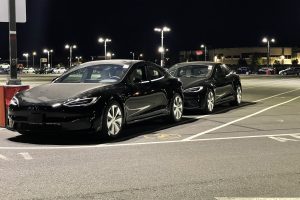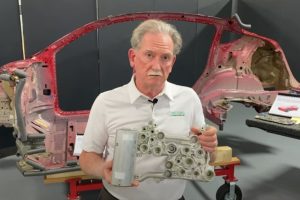Tesla (NASDAQ: TSLA) has filed to build a new battery manufacturing equipment line at the Fremont Factory in Northern California. The factory, which Tesla purchased in 2010, is the only in the company’s lineup to produce all four models. It has not been known as a battery cell or pack manufacturing plant, as the company’s Gigafactory in Sparks, Nevada, produces those EV components. However, the filings indicate Tesla may be looking to slightly expand its cell manufacturing efforts with new production lines at Fremont.
Filed and signed by Tesla on August 30, the permit is labeled as “Tesla F21-0391-A – CTA Battery B-Build.” Tesla gives the following description of the project:
“NEW BATTERY MANUFACTURING EQUIPMENT LINE ON 2ND FLOOR OF MAIN ASSEMBLY BUILDING. THIS PERMIT APPLICATION RELATES TO THE MODULE PORTION OF THE LINE.”
The project is valued at $1.5 million, according to documents seen by Teslarati.

Additionally, another application reveals a $1.3 million project that includes the installation of a new maintenance office, a storage area, production cells with equipment for hood, fender, and trunk lids, and offline cell manufacturing equipment. This project is listed to be on the first floor of the assembly building.
Interestingly, the Fremont Factory has been one of Tesla’s more spacially-confined facilities. Earlier this year, during a visit from Morgan Stanley analysts, including Adam Jonas, the firm noted the Fremont Factory was incredibly tight in terms of storage capacity and room in general. Despite running at a capacity of 20 percent above what has been considered its maximum. “The plant was never designed to produce 450k units (at its peak produced ~300k units before Tesla took it over from Toyota), which was immediately apparent at the tour, ” Jonas wrote in his note describing the visit. “Tesla does not shy away from the fact the plant is inefficiently designed with four assembly buildings, one of which is a tent that cars are assembled in,” referring to GA 4.5, which was made permanent last year.
Just two weeks prior to Morgan Stanley’s visit to Fremont, CEO Elon Musk stated Tesla was considering expanding Fremont “significantly.” While many of us just thought this likely meant an expansion of vehicle production alone, Musk may have been hinting toward an expansion of the manufacturing process altogether.
TESLA BATTERY MANUFACTURING EFFORTS
Tesla has held battery supply deals with Panasonic, CATL, and LG Chem, but has also started building its own cells in-house. In 2020, Tesla unveiled its 4680 battery cell, which has already been prototype-tested by Panasonic. Tesla has been building the cell at the Kato Rd. facility just a few blocks away from Fremont’s front doors. However, the automaker has not scaled this cell to mass production as of yet, and Tesla could always use more battery cells.
With the 4680 cell not quite reaching mass production volumes yet, an order log that grows with what seems to be every minute, and a production volume that just simply has not caught up to Tesla’s demand, it would make sense to expand in-house battery manufacturing efforts as supplementary support.
“I think we’ve said this now for many years. I know has proven true. Tesla does not have a demand problem, we have a production problem. And we’ve almost always had it’s a very rare exception it’s always been a production problem,” Musk said after Q2. “I think that will remain the case.”
REARRANGING AT THE FREMONT FACTORY
Over the past month or so, Tesla has filed to make many significant changes at the Fremont Factory. After we reported on the construction efforts that are seemingly underway, Tesla has also been filing several applications with the City of Fremont for equipment repositioning, as well as the construction of new foundations and manufacturing equipment. Even things as simple as light poles are being repositioned to make way for potential new manufacturing buildings.
Tesla has also started relocating Model S and X production equipment to other portions of the factory. “GASX,” which we can assume is “General Assembly Model S and X,” has had a hoist relocated, according to filings. Tesla has also filed to install production tools and other associated Model S and Model X manufacturing utilities in the factory. This does not necessarily imply that production lines for the two vehicles will be expanding, especially considering the vehicles make up an extremely small portion of Tesla’s overall sales. However, these manufacturing lines may be shifting to other locations at Fremont to make way for the perhaps imminent installation of cell manufacturing lines at Fremont.





